2017 Kawasaki Z1000SX review: a "super bike" for the road
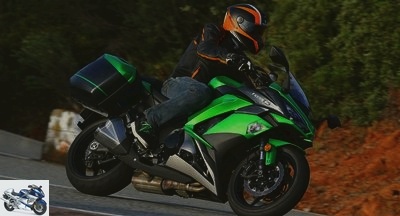
Kawasaki is taking advantage of the changeover to Euro 4 to refine its Z1000SX on many fronts: mechanical, but above all aesthetic and electronic! Sport-GT road bike will arrive in green dealerships in December, but MNC has already been able to test it… First try.
Page 3 – Technical update Z1000SX 2017
Engine
The liquid-cooled, dual ACT, 16-valve, 1,043 cc (77 x 56 mm) in-line 4-cylinder still delivers 142 hp and 111 Nm of torque, but now meets Euro4 emissions standards.
Kawasaki observes – very skillfully – that "the new settings of the electronic control unit (ECU) further soften the power, which promotes machine control, comfort and operator confidence". Changes have also been made to the main and secondary catalysts.
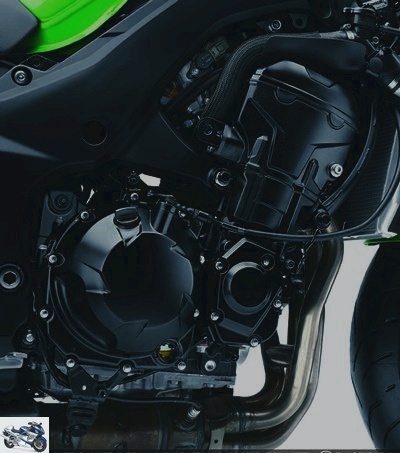
These are the only modifications made to the engine of the Z1000SX, which already benefited in its previous version from inverted injection bodies (38 mm), oval secondary butterflies and additional channels between the cylinders to reduce pressure losses – at high diet especially.
The secondary balancing shaft – driven by a pinion mounted on the 6th crankshaft flyweight – always operates in the heart of the mill in order to limit excessive vibrations as much as possible … But it does not filter them all and unlike this as Kawa advances, these vibrations are not all "good" to take !
The airbox remains housed between the beams of the frame, so that "the air intake can be affected by the heat of the engine," admit the Akashi Greens. But the supply of fresh air via vents located at the front of the fairing sidewalls should limit performance losses. Phew! Warning: this device should not be confused with the Ninja’s "Ram Air", where the forced intake compresses the air entering the box of the same name !
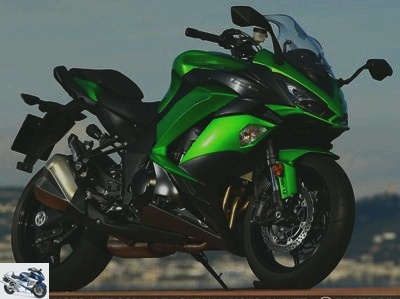
The exhaust system retains its 4-2-2 configuration … even if the silencer tips give the impression of having four outlets! The pipes connecting the exhaust manifolds are still present in order to reinforce "the sensations and the response at all speeds".
Finally, the assisted anti-slip clutch – and already perfected on the – is renewed in its functions. As a reminder, a so-called assistance cam acts as a torque damper by bringing the clutch hub and the pressure plate one against the other, in order to compress the clutch discs, reducing the number of springs (3 instead of 5) and lever effort (-30%). The anti-slipping cam comes into play during hard braking, moving the clutch hub away from the pressure plate and thus limiting the counter torque.
Cycle part
The aluminum frame is maintained on this, still consisting of five cast aluminum parts welded together: the steering column, the left and right main pillars and two transverse joints. The rear frame loop is still made of three pieces of die-cast aluminum. Its lightness contributes to the centering of the masses.
The frame retains its four engine mounts, all rigid except for the upper rear mounting of the engine crankcase, provided by a silentbloc. "The pilot thus perceives the reactions of the engine more directly" … and its vibrations !
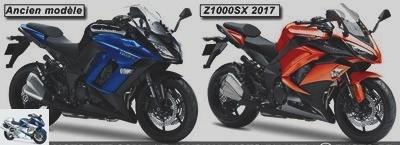
In addition to the use of inverted injection bodies, the weight centering is ensured by the horizontal rear suspension. This "Back-link" type configuration frees up the space occupied by the lower link of the "Uni-Trak" suspension, allowing the expansion chamber to be enlarged and shorter silencers to be fitted..
We note in passing one of the extremely rare changes made to the cycle part: "the calibration of the shock absorber and the travel ratio (+6 mm of travel, Editor’s note) have been reviewed in order to make the suspension work more flexible, for better bump absorption and firmer cushioning. Unexpected consequence: the saddle height drops to 815 mm (-5 mm).
The inverted 41 mm fork adjustable in preload, compression and rebound is retained, as are the brakes mounted on it: the two 300 mm petal discs are bitten by radial monobloc calipers with 4 opposing pistons of different diameter: 32 mm in up and 30 mm down.

The 2017 Z1000SX gets a slight modification at the rear: the 250mm petal disc is clamped by a single piston caliper whose pads change material – obviously better this year, that goes without saying – and the spring reminder is optimized.
The Kawasaki evolves further in terms of protection. On the one hand, its new double curvature screen – still adjustable in three positions without tools – is 15 mm higher. On the other hand, the new fairing is 28mm wider on each side – protecting better from the cool winter wind – and partially covering the frame, which can get hot in summer….
Inspired by the very latest Ninja (and), the new fork crown accommodates two innovative LED headlights which, according to the clever calculations of Japanese engineers, multiply by 1.4 the length of the beam range of the high beam while consuming around 50% less electricity.

The "touristic" claims of the Akashi road roadster also increase thanks to redesigned saddles: wider under the rider, longer by 25 mm under the passenger … and raised by 25 mm at the front to ensure better support braking.
Supplied as standard – optional on the previous model – the passenger handles directly accommodate the suitcases which are wedged on the large lugs of the rear footrests.
Note to the attention of frequent travelers and "commuters" that the suitcases are still not compatible with the Top-case, while they are on the Versys 1000 … Finally, last details: the clutch lever is adjustable in five positions, the mirrors are more apart by 20 mm and the indicators are better integrated.
Electronic
If the mechanics of the Z100SX hardly change, its electronics make a leap forward thanks to the addition of the Bosch IMU (Inertial Measurement Unit) inertial unit which measures longitudinal, transverse and vertical acceleration, angular speed roll and pitch speed. Genuine Kawasaki software even determines the yaw angle…
According to Kawasaki, the famous IMU – known and appreciated by owners of sports motorcycles mainly – gives a real-time image of the orientation of the chassis more clearly than that of predictive programs. The interventions of traction control (KTRC) and anti-lock brake (KIBS) are considerably refined, mainly on the angle.
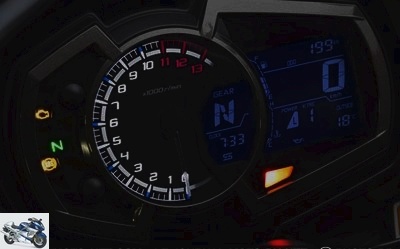
"The KMCF (Kawasaki Cornering Management Function) monitors engine and chassis parameters throughout the turn (entry, chord point, exit), modulating braking force and engine power to smooth the transition acceleration / braking, then the go-around ", adds Kawasaki, convinced that thanks to this," the rider more easily puts the machine in the target trajectory, throughout the turn ".
The Z1000SX retains its three driving modes: "in modes 1 and 2, the intelligent programming allows a certain level of slippage, which is compulsory to maximize acceleration. (…) Insofar as this sophisticated software bases its dynamic analysis on the orientation of the cycle part in relation to the surface of the track (and not in relation to the horizontal plane), it is able to take into account the cant in bends or other slopes, and to adapt to them ".
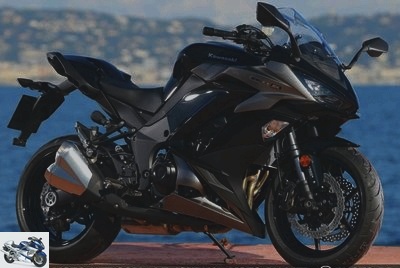
Proactive and non-reactive, the system is "able to predict where traction conditions will deteriorate. By acting before the slip goes outside the optimum traction range, it limits power drops and provides great flexibility", assures Kawa.
When mode 3 is engaged, the system "switches to" three-way "management – that is to say, it manages the ignition timing, the supply and the air regulation (via the secondary butterflies ) – and reduces engine power until grip is regained by the rear wheel ". Perfectly controlled and therefore tolerated in the first two driving modes, lifting the front wheel is impossible in the third mode.
When braking, the KIBS not only controls the front and rear wheel speeds, but also monitors the hydraulic pressure of the front calipers and various parameters provided by the engine ECU (throttle release, engine speed, clutch load and gear engaged).
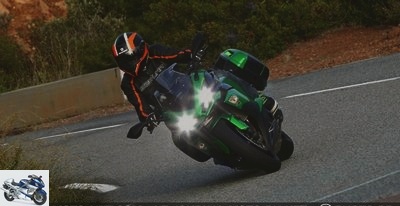
The brake pressure control must keep the pilot’s feeling at the lever as high as possible. It must also – and above all – keep the rear wheel on the ground, minimize rebounds and take into account the counter-torque … in the event that the anti-slip clutch is overtaken by events. ?!
The redesigned dashboard finally integrates a gear indicator light and an original tachometer needle that turns from white to pink, then to red as we approach the speed set for upshifting (range of 5000 at 11,000 rpm, in increments of 250 rpm).
The LCD screen adopts a clear display on a dark background, "a detail that adds to the modernity and sporty look of the instrumentation, considers Kawasaki. In addition to the report indicator, the instrumentation is completed in 2017 with the exterior temperature and indicators for the inertial unit (IMU) and the KIBS.
Related articles
-
2013 Kawasaki ZX-6R 636 review: a super Karrement Supersport ! Take a Kawasaki ZX-6R and increase its displacement to 636 cc to boost its mid-range. Add…
-
2017 Suzuki GSX- R1000R review: the beauty of Gex Driven by the most recent hypersport motorcycles for lack of developments in the last ten years or so,…
-
2017 Suzuki V-Strom 1000 XT test: a super cost ! The Suzuki V-Strom 1000 , relaunched in 2013 after a career suspension in 2008 due to Euro 3 standards,…
-
2017 Kawasaki Z1000SX review: a super bike for the road Kawasaki is taking advantage of the switch to Euro 4 to polish its Z1000SX on many fronts:…
-
2018 Honda Goldwing Touring test: more watts, less cotton wool On an exceptional motorcycle, exceptional measures: after 17 years without major…
-
2020 Z900 test: Kawasaki returns to its Nine-without-aids Successfully launched in 2017, the Kawasaki Z900 evolves in 2020: the roadster changes music…
-
Ninja H2 SX test: sporty road bike, in green and against everything ! Kawasaki has no shortage of air: three years after the launch of its Ninja H2 / R,…
-
Ninja 650 test: Kawasaki camouflages its road in sport In 2017 Kawasaki introduces a new Ninja! Not a pistarde just approved for the road, but the…
-
2020 Z650 test: the Kawasaki roadster not all new but all beautiful ? Launched in 2017 on the competitive medium-displacement roadster market, the…
-
2017 Kawasaki Z1000SX review: a super bike for the road Kawasaki is taking advantage of the changeover to Euro 4 to refine its Z1000SX on many fronts:…